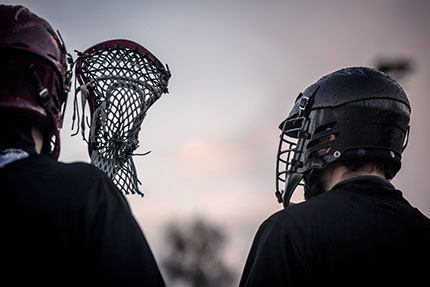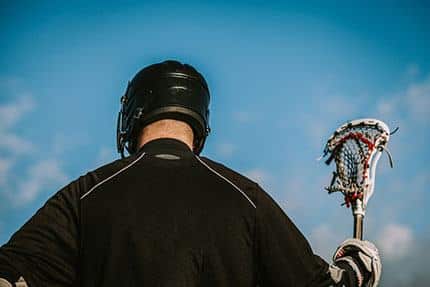Are you a lacrosse player seeking to master the game and stay one step ahead of your competition? Then exploring illegal body check penalty is an essential aspect of your learning journey.
This blog post will provide helpful insight into what constitutes an illegal body check and the implications of breaking such rules.
More...
Take away key points:
If you want to learn more about illegal body checking in lacrosse, refer to the guide below to find all the critical information & ensure fair play.
What is lacrosse illegal body checking?

An illegal body check in lacrosse refers to multiple types of improper or excessive physical contact between two players. One player is usually the aggressor.
An illegal body check is a personal foul in lacrosse and carries a major penalty than technical fouls. Since it uses excessive force that can cause serious injury, the body check is considered illegal and assigns severe penalties or even expulsion from the game.
When is a body check legal in lacrosse?
Body checking is essential to playing lacrosse but requires following specific rules and regulations to ensure player safety.
In men's lacrosse, a legal body check is allowed when a player has possession or is within five yards after a goalkeeper releases the ball from his or her control. In addition, men's players can check opposing players with their shoulders in situations where they do not have immediate possession of the ball.
At the high school and collegiate levels, body checks must take place above the waist and with both hands on the stick.
Women's lacrosse does not involve any body checks, as all contact between two players must be avoided for safety reasons. However, players must remain aware of where other players are on the field to prevent collisions caused by illegal body checks.
Types of illegal body checks
An illegal body check in lacrosse might appear in multiple ways. For instance, a player can body-check the other player who is not in possession of the ball or if the opponent is not within five yards of a loose ball.
However, in youth lacrosse, this distance is reduced to three yards. These body checks are not legal as they target the opposing team that is not a threat due to the ball possession.
Another type of illegal body check is the check when the contact is initiated below or behind the waist. Body checking below the waist causes injuries to the player's legs, and body checking from behind doesn't allow the players to adequately break their fall.
In addition, body checking above the shoulder results in injury to the head or neck. These illegal body checks can cause severe injuries to the opponent even though the players wear helmets. The injuries include brain injuries, concussions, brain injuries, or even broken necks.
Players break the rules with illegal body checks when they initiate contact with other players, fall to the ground, or have different body parts on the ground, not just their feet.
Spearing is yet another form of illegal body checking, and the action includes an offensive player initiating contact with his head. The action might cause injuries to both the offender and his opponent. However, if a player sees a check coming and reacts in such a way as to make the body check illegal, the lacrosse officials will not call a foul.
What are examples of illegal body checks?
There are various examples of the body checking for a better understanding of the violation of the lacrosse rules. Some of them include:
- A player sees his opponent running to capture the loose ball rolling towards them. While the player is five yards away, the opponent crashes into them from the side and throws them to the ground. The opponent gets a personal foul for an illegal body checking and serves a minute of penalty time in the penalty box.
- As a player receives a pass from his teammate, the opposing player rushes from behind and body-checks him below his waist, causing the player to fall. The opposing player initiating the foul receives a penalty time of two minutes into the penalty box.
- A player might run for a loose ball but slip and fall on his hands and knees. While trying to get up, the opponent rushes at him, body-checks him back to the ground, and leads with his head. The opponent receives a personal foul, the referee considers the action aggressive, and the opponent is automatically expelled from the further game.
What will a referee do for violating the rules of body checking?
Once a referee sees the illegal lacrosse behavior and body checking, they assign a personal foul for the offender.
In most leagues, such as youth lacrosse, NCAA, and other leagues, personal fouls earn the offending player one, two, or three minutes of penalty time in the penalty box or even expulsion if there is severe aggressiveness in the offending player.
Due to the personal foul, the non-offensive opposing player and his team receive possession of the ball. But, if an illegal body check proves to be more aggressive, the offender will be ejected from the game.
What is the referee's signal for an illegal body check?
In youth lacrosse and NCAA lacrosse, the signal for illegal body checking is similar.
The referee will clench his fist, bend the elbow, position it beside the chest, and rotate the shoulder so that the elbow can rise upwards towards the referee's head, making a wing-like motion.

Penalties similar to illegal body checking
There are various lacrosse penalties similar to illegal lacrosse body checking. Let's see the most common ones: pushing, unnecessary roughness, tripping, cross-check, and slashing.
Pushing
Pushing in lacrosse is a type of offense that can lead to game penalties. It occurs when a player uses their hands or stick to push or check an opposing player from behind with excessive force.
Pushing from behind can be considered dangerous because it can lead to severe injuries that could have been avoided simply by following the rules and allowing players to compete fairly.
Unnecessary roughness
Unnecessary roughness in lacrosse can take many forms and occur for various reasons.
Physical contact between players is allowed. However, illegal or excessive contact can result in a flagrant foul or an unnecessary roughness penalty.
Examples of actions that constitute an unnecessary roughness offense include striking, tripping, and pushing off with the lower body, a player has possession of the ball and bows the neck or head to initiate contact, to name a few.
Tripping
Tripping in lacrosse is a form of foul play that involves one player hitting, hooking, or obstructing another player's feet.
This action causes them to lose balance and fall, making tripping easily recognizable by anyone watching the game. Therefore, it is considered a dangerous move as it can cause serious injury and should be avoided at all costs.
Illegal cross-check
An illegal cross-check in lacrosse is a violation of the game's rules that occurs when a player uses the shaft of their stick to make contact with an opposing player. The player pushes the opponent with his shaft instead of his hands.
Cross-check in lacrosse can be deliberate or accidental and usually results in a penalty for the offending player.
Slashing
Slashing in lacrosse is an infraction of the rules that occurs when a player uses the stick to make body contact with another player.
It typically involves swinging the shaft or head of the stick at opponents. It can have serious consequences, ranging from a loss of possession to a two-minute penalty, depending on the severity of the contact.
FAQs
Can you body check in box lacrosse?
Yes, you can body check in box lacrosse, but only if you follow the rules - below the shoulders and above the waist.
How does body checking work in lacrosse?
A player will 'attack' his opponent if he has the ball possession or is within five yards of a loose ball. He will aim his torso part below the shoulders and above the waist to prevent him from getting the ball.

How do girls legally check in lacrosse?
When checking in girls' lacrosse, a player must move the stick quickly up and down with a flick of her wrist. The referee will call a foul if her stick touches the opponent's body.
Conclusion
An illegal body check penalty in lacrosse is a severe violation of rules that can result in extreme injuries to the player on the receiving end.
The offender will serve a penalty or be expelled from the game, depending on the severity of the infraction. This rule is in place to protect players and ensure that everyone has a safe and enjoyable experience while playing lacrosse.
